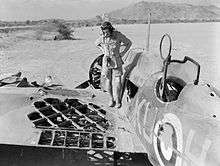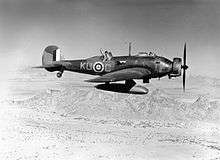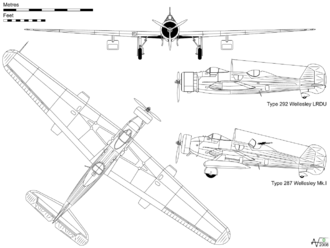Vickers Wellesley
The Vickers Wellesley was a British 1930s medium bomber built by Vickers-Armstrongs at Brooklands near Weybridge, Surrey, for the Royal Air Force. While it was obsolete by the start of the Second World War and unsuited to the European air war, the Wellesley was operated in the desert theatres of East Africa, Egypt and the Middle East. It was one of two planes named after Arthur Wellesley, 1st Duke of Wellington, the other being the Vickers Wellington.
| Wellesley | |
|---|---|
 | |
| Type 292 of the Long-Range Development unit. Unlike production Wellesleys, the engine cowling is blended with the fuselage profile. | |
| Role | General purpose bomber |
| Manufacturer | Vickers-Armstrongs Ltd |
| Designer | Rex Pierson |
| First flight | 19 June 1935 |
| Introduction | 1937 |
| Retired | 1944 |
| Primary users | Royal Air Force Royal Egyptian Air Force South African Air Force |
| Produced | 1936–1938 |
| Number built | 177 |
Design and development

The design originated from the Air Ministry Specification G.4/31 which called for a general purpose aircraft, capable of carrying out level bombing, army co-operation, dive bombing, reconnaissance, casualty evacuation and torpedo bombing. The biplane Vickers Type 253 design, which used a radical geodesic airframe construction, derived from that used by Barnes Wallis in the airship R100, was ordered by the Ministry and tested against the specification along with the Fairey G.4/31, Westland PV-7, Handley Page HP.47, Armstrong Whitworth A.W.19, Blackburn B-7, Hawker P.V.4 and the Parnall G.4/31. The Type 253 was declared the winner, with 150 being ordered.
The Vickers Type 246 monoplane, which used the same geodetic design principles for the fuselage and wings, was then built as a private venture, first flown at Brooklands by Vickers' Chief Test Pilot J "Mutt" Summers, on 19 June 1935 and offered to the RAF.[1] This aircraft had superior performance but did not attempt to meet the multi-role requirements of the specification, being designed as a bomber only. An initial order for 96 Type 246s was substituted for the Type 253 order.[1] The RAF ultimately ordered a total of 176 with the service name "Wellesley", to a newly written specification 22/35, with a 14-month production run starting in March 1937.[2]
The Wellesley was a single-engine monoplane with a very high 8.83 aspect ratio wing and a manually operated, retractable undercarriage. As it was not known how the geodetic structure could cope with being disrupted by a bomb bay, the Wellesley's bomb load was carried in two streamlined panniers under the wings.[3] The Wellesley Mk I had two cockpits but this was slightly changed in what was unofficially dubbed the Wellesley Mk II, whose pilot's canopy was extended to cover the navigator/bomb aimer's position that had been buried in the fuselage. Only the pilot had flight controls. The gunner retained a separate canopy.
Operational history

The RAF received its first Wellesleys in April 1937: they served with No. 76 Squadron RAF at Finningley. The aircraft eventually equipped six RAF Bomber Command squadrons in the UK.[2] Five aircraft with provisions for three crew members were modified for long-range work with the RAF Long-Range Development Flight. Additional modifications included the fitting of Pegasus XXII engines and extra fuel tanks.[2] On 5 November 1938, three of these aircraft under command of Squadron Leader Richard Kellett flew non-stop for two days from Ismailia, Egypt to Darwin, Australia 7,162 miles (11,526 km) setting a world distance record. All three aircraft broke the record, but No. 2 aircraft landed in West Timor, 500 miles (800 km) short of the objective. The Wellesley's record remained unbroken until November 1945.[4] This flight is still the longest by an aircraft with a single piston engine.[5]
By the outbreak of the Second World War, the Wellesley had been phased out from home-based squadrons, with only four examples remaining in Britain, but they remained in service with three squadrons based in the Middle East.[2][6] Following the Italian declaration of war on 10 June 1940, the remaining Wellesley squadrons participated in the East African Campaign against Italian forces in Eritrea, Ethiopia and Somaliland. Although obsolete, the Wellesley formed a major part of the British Commonwealth bomber forces, mainly carrying out raids targeting Eritrea and northern Ethiopia.[6] Sudan-based Wellesleys carried out their first bombing mission on 11 June 1940, against Asmara in Eritrea. Three days later, they were involved in their first air combat, when Capitano Mario Visintini, future top-scoring biplane ace of the Second World War, intercepted a pair of Wellesleys from 14 Squadron on their way to bomb Massawa. Visintini, who was flying a Fiat CR.42, shot down the aircraft K7743, flown by Pilot Officer Reginald Patrick Blenner Plunkett. It was the first of Visintini's 16 air victories in Eastern Africa.[7][8]
In the early part of the campaign, fighter escort was not available and when caught by CR.42s, Wellesleys proved vulnerable to the Italian biplane fighter. Despite this, the Wellesley continued to be sent on bombing raids, bombing Addis Ababa from Aden on 18 August.[9] The Wellesley continued in use against the Italians over East Africa until November 1941, when Gondar, the last Italian-held town, fell to Commonwealth and Ethiopian forces. The final Wellesley-equipped unit, 47 Squadron, was then switched to maritime reconnaissance duties over the Red Sea, continuing in this role until September 1942.[10]
While the Wellesley was not a significant combat aircraft, the design principles that were tested in its construction were put to good use with the Wellington medium bomber, which became one of the mainstays of Bomber Command in the early years of the European war. In February 1940, three Wellesleys (K7728, K7735 and K8531) were sold to Egypt to serve in the Royal Egyptian Air Force.[11]
Variants
- Type 281 Wellesley
- Company designation for the Wellesley bomber.
- Type 287 Wellesley Mk I
- Two, and later three-seat medium bomber aircraft. The Wellesley Mk I had separate canopies for pilot and gunner's cockpits.
- Wellesley Mk II
- Unofficial designation used for examples with an extended canopy covering pilot and bomb aimer.
- Type 289
- Engine testbed to test the Hercules HE15 radial piston engine.
- Type 291
- Blind-flying model.
- Type 292
- Five aircraft modified for long-distance flying by the RAF's Long-Range Development Unit Flight. Alterations included extensive development work with a fuel dumping system, to allow an emergency landing early in a long distance flight when fuel weight would exceed the maximum landing weight. Visible differences included NACA type long chord cowlings. Three were used on the record-breaking flight.
- Type 294
- Prototype with strengthened wing for cutting barrage balloon cables.
- Type 402
- Three-seat experimental aircraft.
Operators
Specifications (Wellesley)

Data from The Wellesley: Geodetics in Action [12]
General characteristics
- Crew: 3 (pilot, bomb-aimer, and rear-gunner)
- Length: 39 ft 3 in (11.96 m)
- Wingspan: 74 ft 4 in (22.66 m)
- Height: 15 ft 3 1⁄2 in (4.661 m)
- Wing area: 630 sq ft (59 m2) [13]
- Empty weight: 6,760 lb (3,066 kg)
- Gross weight: 11,048 lb (5,011 kg)
- Max takeoff weight: 12,500 lb (5,670 kg)
- Powerplant: 1 × Bristol Pegasus XX radial engine, 925 hp (690 kW)
Performance
- Maximum speed: 228 mph (367 km/h, 198 kn) at 19,700 ft (6,000 m)
- Cruise speed: 180 mph (290 km/h, 160 kn) at 15,000 ft (4,600 m) (57% power)
- Range: 1,220 mi (1,960 km, 1,060 nmi)
- Service ceiling: 25,500 ft (7,800 m)
- Time to altitude: 17.8 min to 15,000 ft (4,600 m)
Armament
- Guns: ** 1 × .303 in (7.7 mm) Vickers machine gun in right wing
- 1 × .303 in (7.7 mm) Vickers K machine gun in rear cockpit
- Bombs: 2,000 lb (910 kg) of bombs
See also
Related development
Aircraft of comparable role, configuration and era
Related lists
References
| Wikimedia Commons has media related to Vickers Wellesley. |
Citations
- Mason 1994, p. 237.
- Crosby 2007, p. 145.
- Mason 1994, pp. 237–238.
- Barfield 1973, p. 89.
- Murray 2009
- Air International July 1980, p. 33.
- Sutherland & Canwell 2009, p. 32.
- Skulski 2007, p. 40.
- Air International July 1980, p. 49.
- Air International July 1980, p. 50.
- Barfield 1973, p. 93.
- Air International July 1980, p. 31.
- Andrews and Morgan 1988, p. 308.
Bibliography
- Andrews, C.F. and E.B. Morgan. Vickers Aircraft since 1908. London: Putnam, Second Edition 1999. ISBN 0-85177-815-1.
- Barfield, Norman. Vickers Wellesley Variants (Aircraft in Profile 256). Windsor, Berkshire, UK: Profile Publications Limited, 1973.
- Crosby, Francis. The World Encyclopedia of Bombers. London: Anness Publishing Ltd., 2007. ISBN 1-84477-511-9.
- Massimello, Giovanni and Giorgio Apostolo. Italian Aces of World War Two. Oxford: Osprey Publishing, 2000. ISBN 978-1-84176-078-0.
- Spick, Mike: The complete fighter ace – All the World's Fighter Aces, 1914–2000. London, Greenhill Books, 1999. ISBN 1-85367-255-6.
- Mason, Francis K. The British Bomber since 1914. London: Putnam Aeronautical Books, 1994. ISBN 0-85177-861-5.
- Murray, Dr. Iain. Bouncing-Bomb Man: The Science of Sir Barnes Wallis. Yeovil, Somerset, UK: J.H. Haynes & Co Ltd., 2009. ISBN 978-1-84425-588-7.
- Skulski, Przemysław: Fiat CR.42 Falco. Redbourn, UK: Mushroom Model Publications, 2007. ISBN 83-89450-34-8.
- Sutherland, Jon & Diane Canwell: Air War East Africa 1940–41 The RAF versus the Italian Air Force. Barnsley (South Yorkshire) Pen and Sword Aviation, 2009. ISBN 978-1-84415-816-4.
- "The Wellesley: Geodetics in Action." Air International, Volume 18, No. 1, July 1980, pp. 25–33, 49–50. Bromley, Kent, UK: Pilot Press. ISSN 0306-5634.